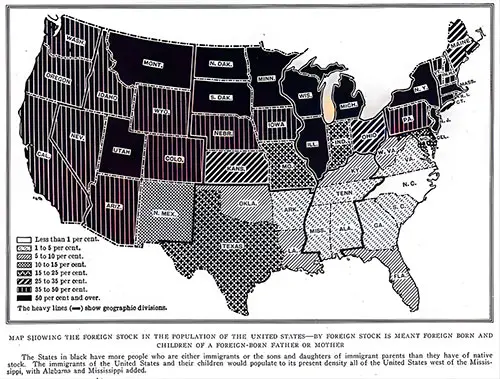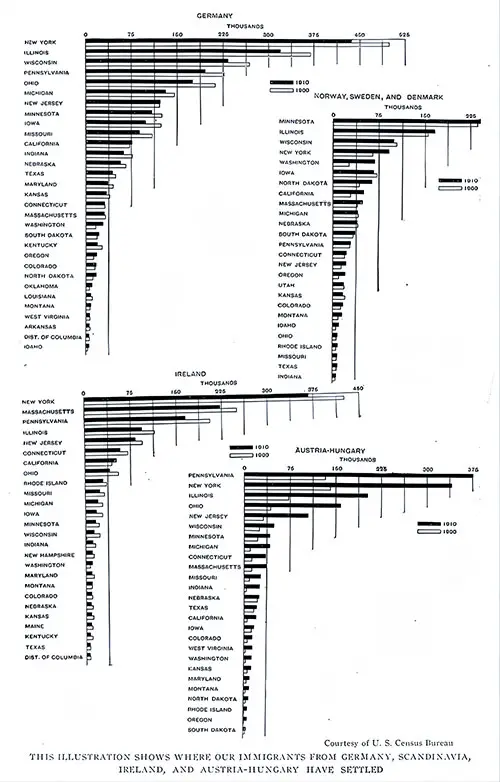The Impact of Immigrants on America: A 1917 National Geographic Overview
📌 Explore the significance of immigration in early 20th-century America. This 1917 article from National Geographic delves into the cultural, economic, and social contributions of foreign-born citizens, alongside the challenges of restrictive immigration policies.
Our Foreign-Born Citizens (1917)
Relevance to Immigration Studies
The article "Our Foreign-Born Citizens" from the February 1917 edition of National Geographic Magazine is an invaluable resource for teachers, students, genealogists, historians, and anyone interested in U.S. immigration history.
It offers a comprehensive analysis of the demographic shifts due to immigration, the significant contributions immigrants have made to American society, and the evolving debates surrounding immigration policies during the early 20th century.
By examining the impact of immigration on the population and economy, this article provides a nuanced view of how immigrants shaped America, particularly in the context of industrial growth, labor, and cultural integration.
Map Showing the Foreign Stock in the Population of the United States – By Foreign Stock, we Mean Foreign Born and Children of a Foreign-Born Father or Mother. The States in black have more people who are either immigrants or the sons and daughters of immigrant parents than they have of native stock. The immigrants of the United States and their children would populate to its present density all of the United States west of the Mississippi, with Alabama and Mississippi added. The National Geographic Magazine, February 1917. GGA Image ID # 14c99741b3. Click to View a Larger Image.
Although the immigrants who have flocked to our shores since 1776 have mingled their blood with pre-Revolution strains until the American of unadulterated colonial ancestry is the exception and not the rule; although a great political party was formed and the presidential campaign of 1856 was fought with the immigration question as practically the paramount issue: although the coming of the Irish and the eastern European each, in turn, stirred the nation, there never has been a time when the subject of our foreign-born population occupied such a deep place in the minds of the people as it does today.
Should we have departed from our time-honored custom of making America a homeland for whoever loves freedom for himself and craves liberty for his children, whether he be literate or illiterate?
Would our polyglot population be a menace in wartime, or would it, as we have proudly thought in the past, be fused into one liberty-loving, flag-defending race?
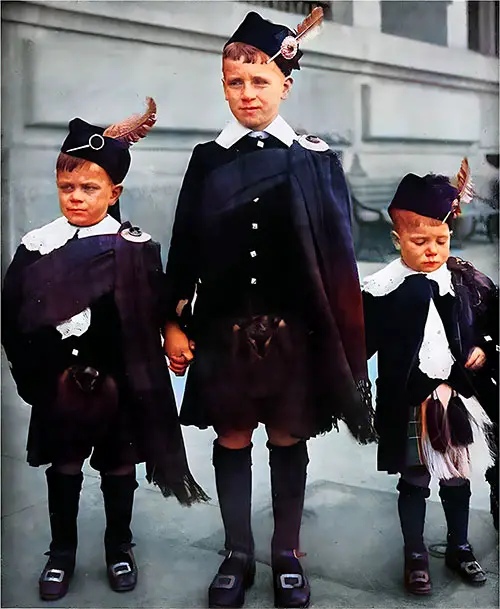
Scottish Immigrant Children at Ellis Island. Taunted with the fact that in England oats were fed to horses and in Scotland to men, a famous Scot replied that England was recognized for its horses and Scotland for its men. America knows how much it is indebted to Scotland and the Scotch-Irish. Nearly half of our Presidents have been either Scotch or Scotch-Irish. Photograph from Frederic C. Howe. The National Geographic Magazine, February 1917. GGA Image ID # 14c9a31ec1
And when the war is over, and the world escapes from the horrible nightmare of blood and carnage and hate, will the consequent burdens drive hordes of people to America, as did the potato famine in Ireland, the social and political unrest in Germany in the decade preceding our Civil War, and other economic hardships in continental countries?
The Most Frequently Vetoed Measure in American History
Never in the history of the American people has Congress passed a measure as often and vetoed by the President as many times as the immigration bill recently enacted into law. Three Presidents of the United States have felt so keenly that the founders of the government and their successors were correct in holding that the lack of opportunity to learn to read and write should not bar an alien from freedom's shores that they have overridden the will of four Congresses and have interposed their veto between the congressional purpose and the unlettered immigrant's desire.
But Congress was finally strong enough to override the presidential veto. So, the immigration doctrines of a century and a quarter have changed, and the practices of generations are to be made over. Hereafter, no one above the age of 16 who cannot read and write may enter.
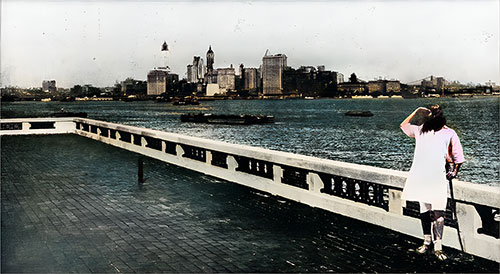
A Russian Hebrew Vegetarian Immigrant at Ellis Island: New York City in the Background. In normal times, Ellis Island might be called the World Congress of Costumes. Everything but the Habiliments of Eden seems to pass muster there. The National Geographic Magazine, February 1917. GGA Image ID # 14ca022d14
A few figures may show the effect of the literacy test applied to future immigration. More than one-fourth of all the immigrants admitted to the United States in the past two decades who were over 14 could neither read nor write.
Of the 8,398,000 admitted in the ten years ending with 1910, 2,238,000 were illiterate. Yet illiteracy melts away so rapidly that, adding to this number all the illiterates here before these came, there were only 1,600,000 illiterate foreigners in the United States when the 1910 census was taken.
Under a literacy test, we will turn back one-fourth of the Armenians, two-fifths of the Serbians, Bulgarians, and Montenegrins, more than a fourth of the Jews and Greeks, more than half of the South Italians, more than a third of the Poles and Russians, and a fourth of the Slovaks.
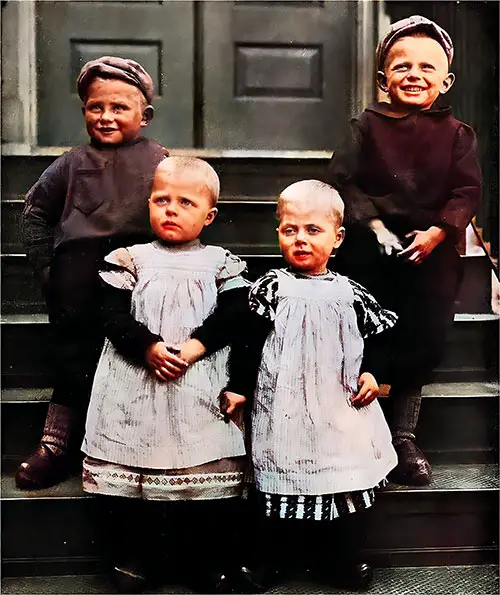
Four Little Dutch Immigrant Children Just Arrived at Ellis Island. Generations of careful living such as is always necessary for a country of narrow boundaries and expanding population has developed in the Dutch a frugality and contentment with simple pleasures that cannot be excelled. Photograph from Frederic C. Howe. The National Geographic Magazine, February 1917. GGA Image ID # 14ca09c352
Who can estimate our debt to immigration? Thirty-three million people have made the long voyage from alien shores to our own since it was proclaimed that all men are born free and equal, and liberty's eternal fire was kindled first on American soil!
It is as if half the German Empire should embark for America or all of England except the county of Kent. It is as if all of the population of the States of the United States west of the Mississippi, plus that of Alabama, should have come bodily to America.
History records no similar movement of a population that in rapidity or volume can equal this. Compared to it, the hordes that invaded Europe from Asia, great and enormous as they were, were insignificant.
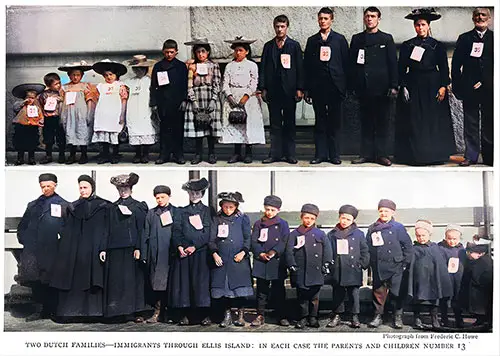
Two Dutch Families – Immigrants Through Ellis Island: In Each Case, The Parents and Children Number 13. Photographs from Frederic C. Howe. The National Geographic Magazine, February 1917. GGA Image ID # 14ca0d16a6
Of the 33,000,000 who have come, more than 14,000,000 still live among us, and their children and children's children are now in good truth bone of our bone and blood of our blood.
Not long ago, America's population crossed the hundred-million mark, and it is interesting to note the composition of that population.
To begin with, there are 11,000.000 colored people, including negroes, Indians, Chinese, etc. Then there are 14,500,000 people of foreign birth among us. In addition, there are 14,000,000 children of foreign-born fathers and mothers and 6.500,000 children of foreign-born fathers and native mothers, or vice versa.
When all of these have been deducted from the 100,000,000, only 54.000,000 remain of full white native ancestry.
Notable People of Foreign Stock
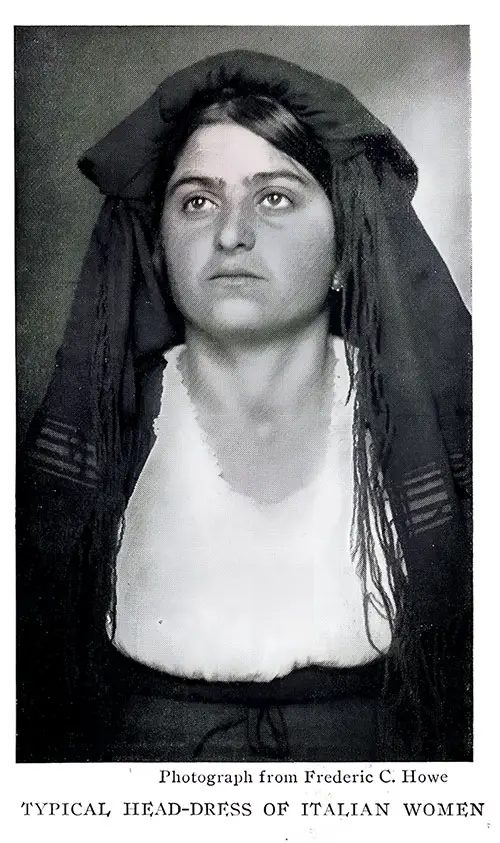
Typical Head-Dress of Italian Immigrant Women, Passing Through Ellis Island. Photograph from Frederic C. Howe. The National Geographic Magazine, February 1917. GGA Image ID # 14ca62f9ad
Yet the 35,000,000 American people who are of foreign stock — that is, foreign-born or the children of a foreign-born parent — include some of the most illustrious citizens of our Republic.
Even the President of the United States has only one ancestor who was born in America, and the list is long and notable of statesmen, captains of industry, leaders of finance, inventors, and makers of literature and progress who have strains of blood not more than one generation on this side of the sea.
An examination of the statistics of American immigration shows that since the foundation of our government, the United Kingdom of Great Britain and Ireland have contributed 8,400,000 of her people and Germany more than six million. Ireland, with more than four million; Great Britain, with a little less than four million; and Scandinavia, with something less than two million, have, together with Germany, contributed more than half of the total immigration to our shores since the beginning of the Revolutionary War.
When we compare the German immigration to the United States between 1776 and 1890 with that from other countries, a somewhat startling result, and one usually unsuspected, is disclosed.
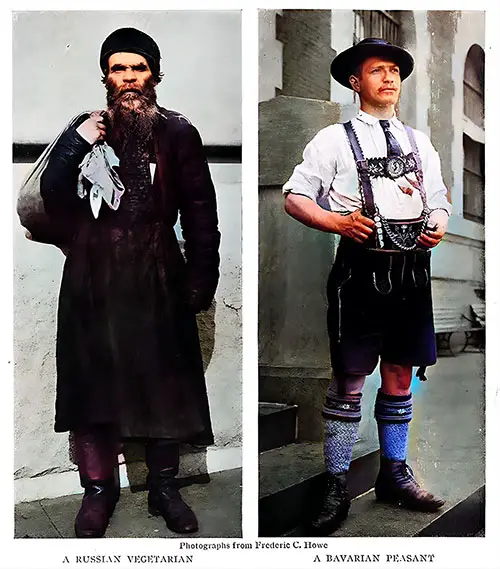
Two Immigrants Passing Through Ellis Island. On the Left, A Russian Vegetarian. On the Right, a Bavarian Peasant. Photographs from Frederic C. Howe. The National Geographic Magazine, February 1917. GGA Image ID # 14ca7041ed
The total arrivals of aliens in those 114 years aggregated 15,689,000, of whom more than 6,000,000 were British and Irish and 5,125,000 were Germans. This shows that one alien out of every three arriving in America during more than a century of our existence was a German. Only the United Kingdom shows a higher proportion.
The trend has been very different since 1890. With more than 17,000,000 immigrant arrivals since that date, only 1,023,000 have been Germans. If a proper deduction is made for those who returned to their homeland and those who have died since their arrival, it will be seen that there are fewer than a million former subjects of the Kaiser in this country who have not been here for more than twenty-six years.
Of more than 8.000,000 people of German birth and immediate ancestry among us, less than 1,000,000 fail to have the background of birth or long residence in America behind them.
Ireland's Gift to America
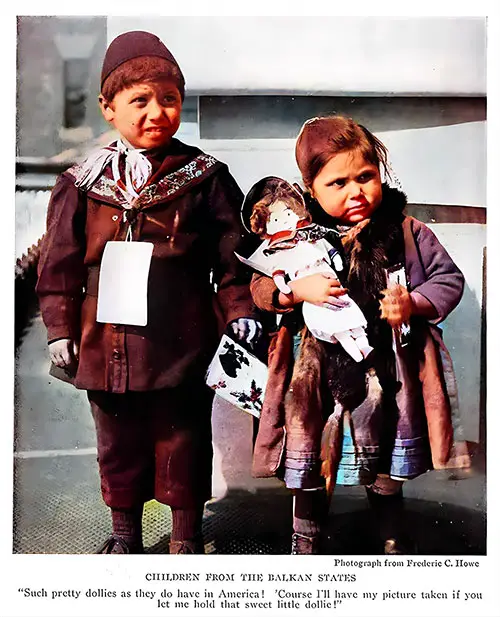
Immigrant Children from the Balkan States at Ellis Island. "Such pretty dollies as they do have in America! 'Course I'll have my picture taken if you let me hold that sweet little dolly!" Photograph from Frederic C. Howe. National Geographic Magazine, February 1917. GGA Image ID # 14cb4aa622
It is interesting to note the other foreign elements that have entered into the makeup of the American population since 1776. What a wealth of blood that wonderful little island, Ireland, has given us!
More Irish people have crossed the seas to become part of us than have remained behind. It is remarkable that so small an island — smaller, indeed, than the State of Maine — could, in a century and a half, send us enough people to duplicate the present population of eleven of our States having an aggregate area as large as the United Kingdom, France, Germany, and Austria-Hungary together.
Austria-Hungary stands next on the list of contributors to the immigrant stream that has flowed from Europe to America. Although Austro-Hungarians began to immigrate in considerable numbers only when the arrivals from Western Europe began to fall off, sufficient have come from the dual monarchy to populate the State of Texas to its present density.
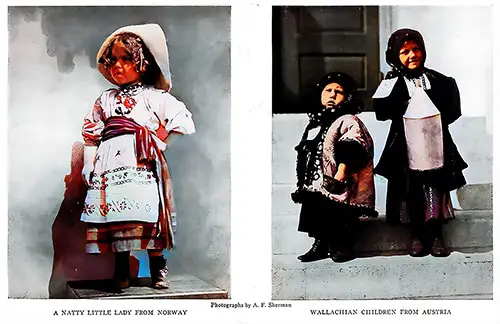
Adorable Immigrant Children at Ellis Island. On the Left, a Natty Little Lady from Norway. On the Right, Wallachian Children from Austria. Photographs by A. F. Sherman. National Geographic Magazine, February 1917. GGA Image ID # 14cb68620a
Italy has sent us enough of her people to duplicate the Montana, Wyoming, Idaho, Oregon, Nevada, Utah, Colorado, Arizona, and New Mexico populations. At the same time, England's and Scotland's contribution, 3.889,000 in all, together with Ireland's 4.500,000, gives a total of 8,389,000, or plenty to populate all of the States lying west of Texas and the Dakotas.
The 3,419,000 Russians who have come to our shores could replace half of New England's population.
Although people of foreign birth constitute only one-seventh of the country's population, they contribute nearly one-fourth (22 percent) of the nation's arm-bearing strength.
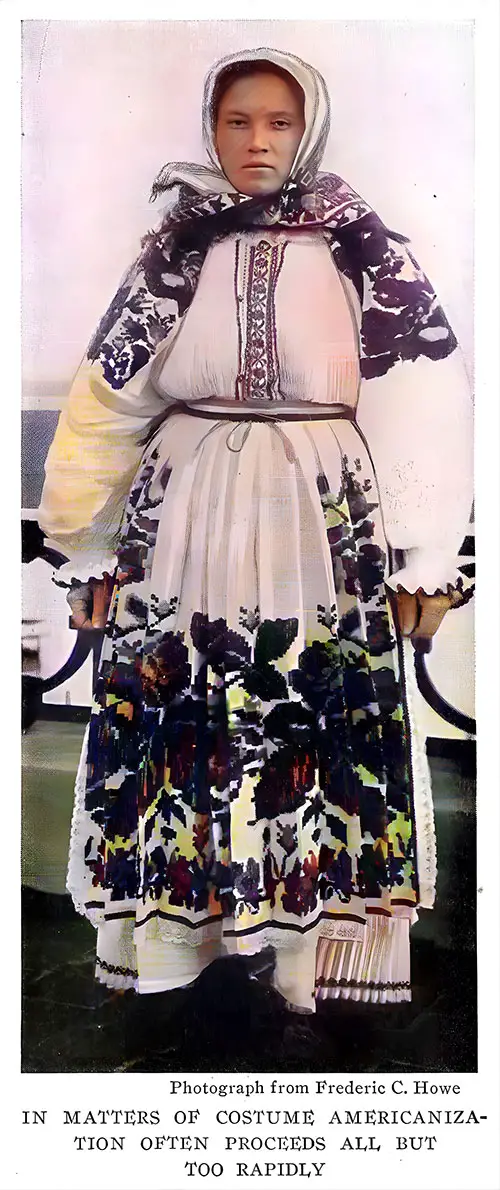
In Matters of Costume, Americanization Often Proceeds All but Too Rapidly. Immigrant in Folk Costume at Ellis Island. Photograph from Frederic C. Howe. The National Geographic Magazine, February 1917. GGA Image ID # 14cba3b1c4
At the last census, many of the States had a higher number of foreign-born men of arm-bearing age than they had of native ancestry citizens, among them Massachusetts, Rhode Island, Connecticut, New York, New Jersey, and Wisconsin. Minnesota, and North Dakota.
Taking the States where those of foreign birth and their sons together constitute a significant portion of the men between the ages of 18 and 44, it will be found that the list includes the above States and the following: New Hampshire, Pennsylvania, Michigan, South Dakota, Nebraska, Montana, Idaho, Arizona, Utah; Nevada, Washington, and California —in all 20 States. We have considerably over 20,000,000 men of military age in the United States.
The Immigrant's Preference for City Life
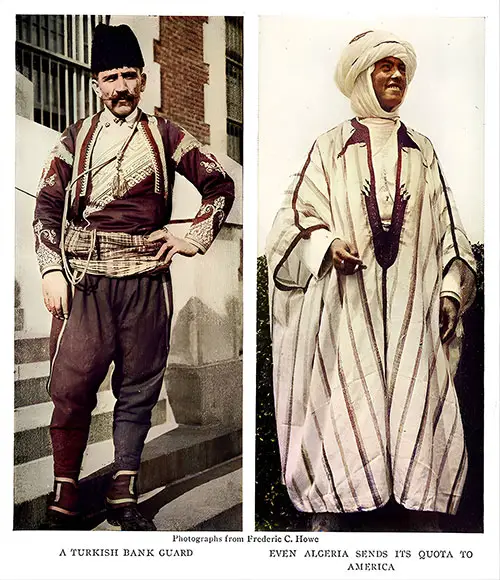
Two Immigrants at Ellis Island. On the Left, a Turkish Bank Guard, and, on the Right, An Algerian, who is part of the Annual Quota for Algeria. Photographs from Frederic C. Howe. The National Archives, February 1917. GGA Image ID # 14cc0f9f0e
Another striking fact of our immigration situation is the great preference of the foreign-born and their children for the cities. Of the 35.000.000 foreign-stock whites living in the United States, approximately 23,000,000 live in the cities. In only 14 of the 50 leading cities of the country, the whites of full native parentage constitute as much as half of the total population.
Only one-fifth of New York and Chicago residents are of native white ancestry. Less than a third of Boston, Cleveland, Pittsburgh, Detroit, Buffalo, San Francisco, Milwaukee, Newark, Minneapolis, and Jersey City communities are of native white ancestry. Providence, St. Paul, Worcester, Scranton, Paterson, Fall River, Lowell, Cambridge, and Bridgeport are of native white ancestry.
Conditions have played some curious pranks in the distribution of the immigrant population in the United States.
More than two-thirds of the Germans live between the Hudson and the Mississippi and north of the Ohio River. The same is true of the Austrians, the Belgians, the Hungarians, the Italians, the Dutch, the Russians, and the Welsh.
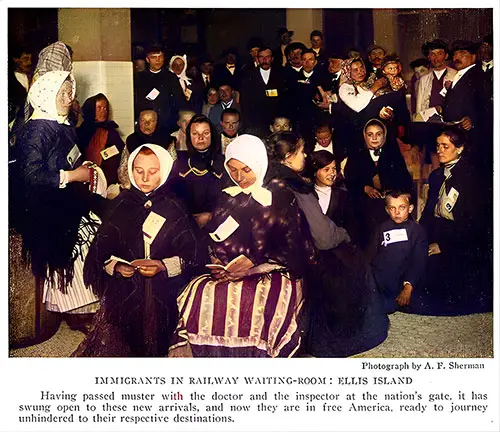
Immigrants in Railway Waiting-Room: Ellis Island. Having passed muster with the doctor and the inspector at the nation's gate, it has swung open to these new arrivals, and now they are in free America, ready to journey unhindered to their respective destinations. Photograph by A. F. Sherman. The National Geographic Magazine, February 1917. GGA Image ID # 14cc17001c
New York, Pennsylvania, and New Jersey have 47 percent of the Austrians, 34 percent of the English, 30 percent of the Germans, 54 percent of the Hungarians, 45 percent of the Irish, 58 percent of the Italians, 56 percent of the Russians, 34 percent of the Dutch, and 46 percent of the Welsh in the United States.
Nineteen-Twentieths of Our Foreign-Born Came from Countries at War
An examination of the data shows that nearly nineteen-twentieths of our foreign-born population comes from the countries in Europe currently at war.
With such a surprising number of people among us who first beheld the light of day under flags now flying over Europe's battlefields, does it not speak well for our country's adopted children that there have been no more evidence of hyphens than the past thirty months have disclosed?
This Illustration Shows Where Our Immigrants from Germany, Scandinavia, Ireland, And Austria-Hungary Have Settled. Courtesy of the US Census Bureau. The National Geographic Magazine, February 1917. GGA Image ID # 14cc1a3560. Click to View a Larger Image.
The war in Europe has mostly closed the gates of that continent to the emigrants. However, three short years ago, Ellis Island, the most significant immigrant gateway in the world, was one of the busiest places on the face of the earth.
The wheels of the great machine that carried the incoming alien through the doors of America turned fast and long. Morning, noon, and night, the men who manned this excellent mechanism labored as seldom men have to work to keep the machine moving fast enough to take care of the vast flood of humanity presenting itself there for inspection and adoption.
Now, all is different. Military necessity must be served, and hundreds of thousands, perhaps millions, of those who would have come to man our ever-expanding industries are now on the battlefields of Europe, some still surviving the awful avalanche of fire and steel, and others, alas, asleep in those last trenches where the unending truce of death has stilled the enmities of life! Ellis Island is a somewhat lonely place today.
The twelve hundred thousand who came in 1914 were followed by the three hundred thousand in 1916.
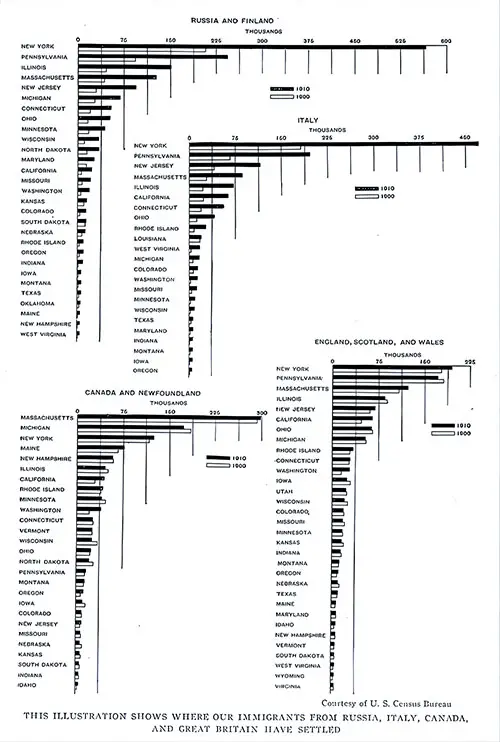
This Illustration Shows Where Our Immigrants from Russia, Italy, Canada, And Great Britain Have Settled. Courtesy of the US Census Bureau. The National Geographic Magazine, February 1917. GGA Image ID # 14cc54bd98
The War's Relation to Immigration
But what of the morrow of American immigration? Will the war, whose military necessities all but stopped the immigrant tide from Europe, be followed by a peace whose economic opportunities will have the same effect?
One searches the pages of history in vain for a satisfactory answer. The history of past wars throws no particular light upon it. After our Civil War, the South, burdened with debts, wanted a million things.
But empty pocketbooks and poor credit combine to create little buying power. The South, unable to solve its economic difficulties at once, had to watch thousands of its people leave for the North and West to start over again.
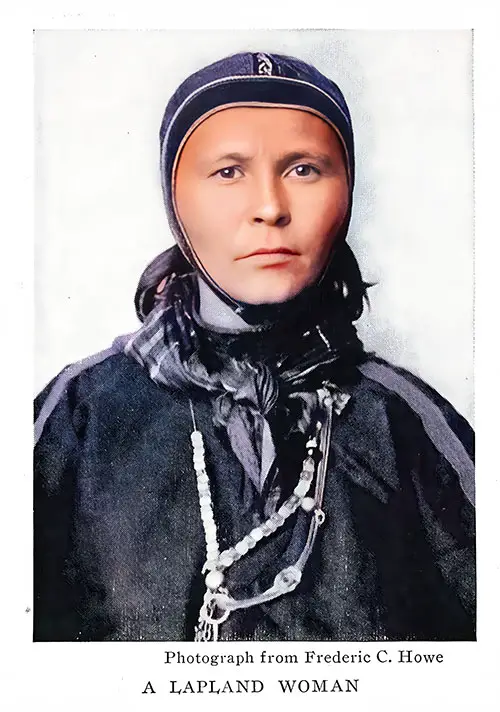
A Lapland Immigrant Woman at Ellis Island. Photograph from Frederic C. Howe. The National Geographic Magazine, February 1917. | GGA Image ID # 14cc80fd5a
The end of the Russo-Japanese War brought vast hordes of Russians to our shores, economic necessity compelling them to leave their homelands unrestricted to their respective destinations.
On the other hand, the Franco-Prussian War sent only an average number of French people to America as one of its aftermaths. All the people who left Europe following the Napoleonic Wars were fewer in number than those coming here in a single three-month period of our average immigration history.
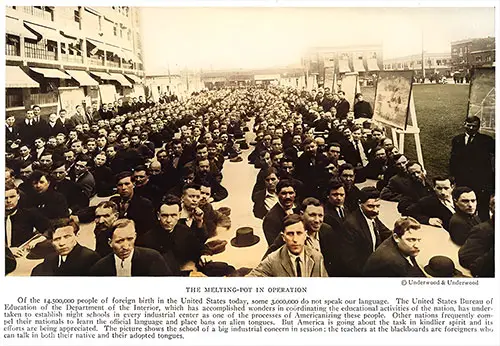
The Melting Pot in Operation. Of the 14,500,000 people of foreign birth in the United States today, some 3.000,000 do not speak our language. The United States Bureau of Education of the Department of the Interior, which has accomplished wonders in coordinating; the educational activities of the nation, has undertaken to establish night schools in every industrial center as one of the processes of Americanizing these people, Other countries frequently compel their nationals to learn the official language and place bans on alien tongues. But America is going about the task in kindlier spirit, and its efforts are being appreciated. The picture shows the big school of a big industrial concern in session; the teachers at the blackboards are foreigners who can talk in both their native and their adopted tongues. © 1917 Underwood & Underwood. The National Geographic Magazine, February 1917. GGA Image ID # 14ccf9e984
Some say that the South could not rebuild after the Civil War because it did not get the support of the Federal Government—help that the governments of Europe would have given their people.
They point out that none of the warring nations, however much they may owe, have borrowed as near to the margin of their credit as many Latin American countries and that people who would not buy their war bonds will readily take their peace obligations.
They point to Baltimore and San Francisco's experiences to show how new prosperity and fresh resources can emerge from the ashes of calamity.
Six Panama Canals A Year Interest Charge
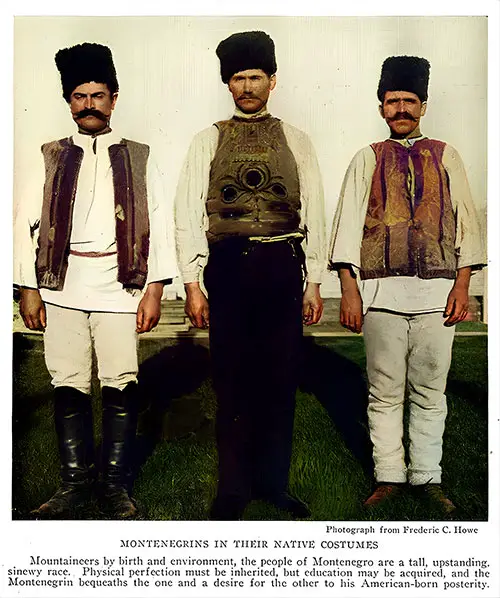
Montenegrins In Their Native Costumes at Ellis Island. Mountaineers by birth and environment, the people of Montenegro are a great, upstanding, sinewy race. Physical perfection must he inherit, but education may be acquired, and the Montenegrin bequeaths the one and a desire for the other to his American-horn posterity. Photograph from Frederic C. Howe. The National Geographic Magazine, February 1917. GGA Image ID # 14cd1fca77
However, the difference between an isolated city and practically a whole continent is too vast for such an analogy to be significant. Furthermore, no state, nation, or continent has ever staggered under such an overwhelming debt.
If the war were to end now, its financial obligations alone, to say nothing of the devastation, would reach $60,000,000,000. Think of a continent with much of the flower of its brains and brawn either dead or maimed.
Vast areas of its fertile territory are in ruins, facing a debt whose annual interest charges will equal the cost of six Panama canals! And that continent one which, before the war, sent us a million of its people every year because living was hard at home!
Whoever has stood at the gate at Ellis Island and watched the human tide surge through, and whoever has traveled among the peasants of Europe must realize how narrow the margin was between their total income and their necessary outgo before the war.
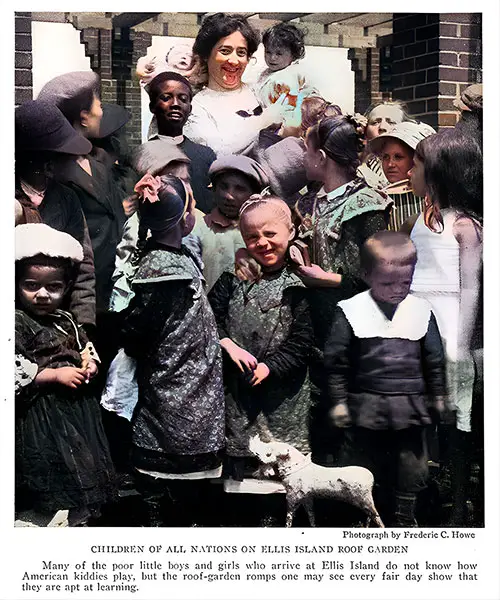
Children of All Nations on the Ellis Island Roof Garden. Many of the poor little boys and girls who arrive at Ellis Island do not know how American kiddies play. Still, the roof-garden romps one may see every good day show that they are apt at learning. Photograph by Frederic C. Howe. The National Geographic Magazine, February 1917. GGA Image ID # 14cd671675
Against these things, the efficiency that the war has forced upon the people and the nations must be matched with the spirit of self-sacrifice it has engendered.
America has always been a multilingual nation, although all tongues finally melt into hers. It is said that twenty years after Hudson discovered Manhattan, fourteen languages were spoken in New Amsterdam.
The religious wars in the seventeenth and eighteenth centuries sent thousands and tens of thousands of French Huguenots, German Protestants, and English Puritans to our shores.
One American-built vessel is said to have made 116 round trips between New York and Liverpool in nineteen years. During this time, it brought 30,000 immigrants to America.
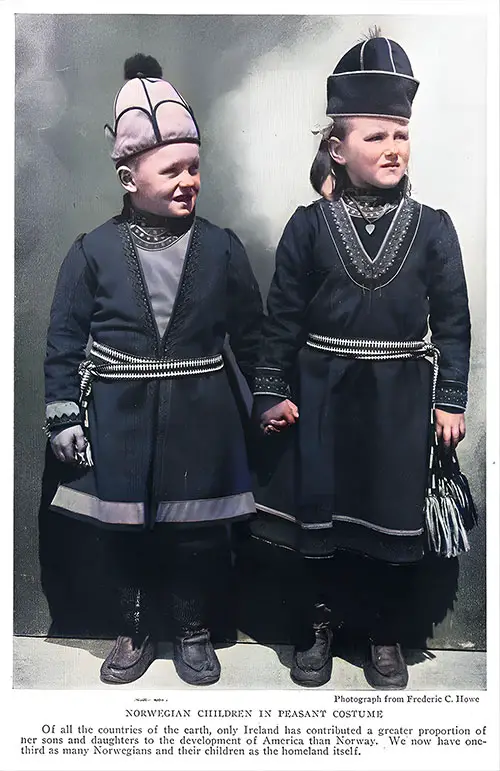
Peasant Norwegian Immigrant Children in Folk Costumes. Of all the countries of the earth, only Ireland has contributed a higher proportion of her sons and daughters to the development of America than Norway. We now have one third as many Norwegians and their children as the homeland itself. Photograph from Frederic C. Howe. The National Geographic Magazine, February 1917. GGA Image ID # 14cdb0c478
A Max Valued at Fifty Dollars
The first colonial charter granted by England for the new settlement was conditioned on homage and rent. This was the Virginia charter for the land extending from Cape Fear to Halifax, the rent of which was one-fifth of the net produce of gold, silver, and copper.
The provision that a planter might add fifty additional acres of land for every person he transported into Virginia at his own cost promoted the land aristocracy.
When the Pilgrims were outfitting, each immigrant was rated ten pounds at the capital. No divisions of profits were to be made for seven years.
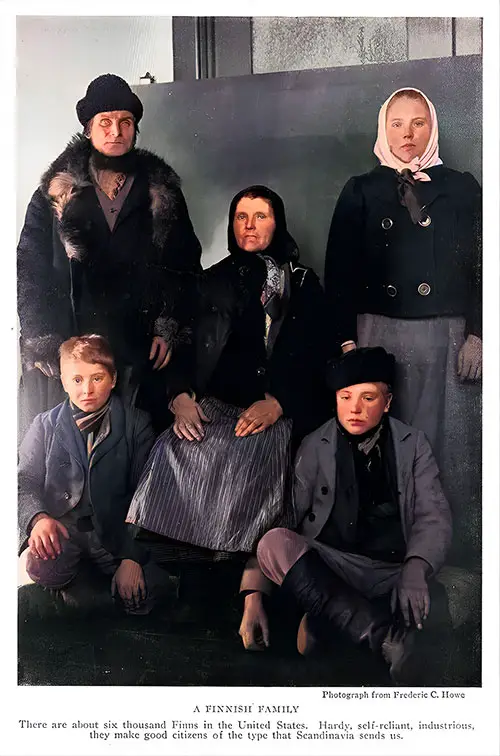
A Finnish Immigrant Family at Ellis Island. There are about six thousand Finns in the United States. Hardy, self-reliant, industrious, they make good citizens of the type that Scandinavia sends us. Photograph from Frederic C. Howe. The National Geographic Magazine, February 1917. GGA Image ID # 14cdb838fd
In the early days, the people who came were mainly of the sturdy pioneer type. A great many of them could neither read nor write, while most of those who could could do so only in a limited way.
Many names in America were transposed because public officials were careless or unable to spell men's names straight in deeds, wills, and other documents.
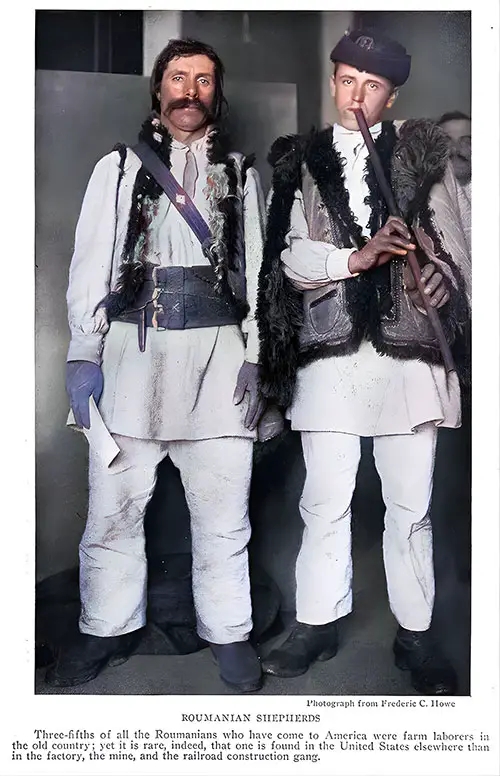
Romanian Shepherds at Ellis Island. Three-fifths of all the Romanians who have come to America were farm laborers in the old country. Yet, it is rare. Indeed, that one is found in the United States elsewhere than in the factory, the mine, and the railroad construction gang. Photograph from Frederic C. Howe. The National Geographic Magazine, February 1917. GGA Image ID # 14cded2d5c
Governor Berkeley Opposed the Printing Press
In 1718, three hundred and nineteen Scotch-Irish empowered their agent to negotiate terms with the Governor of Massachusetts for their settlement in that colony.
Ninety-six percent of the whole number wrote their names out in full. It has been said that at that time, in no other part of the British Empire, such a proportion of men miscellaneously selected could have written their names.
Twenty-six percent of the German male immigrants above sixteen who came to America in the first half of the eighteenth century made their mark.
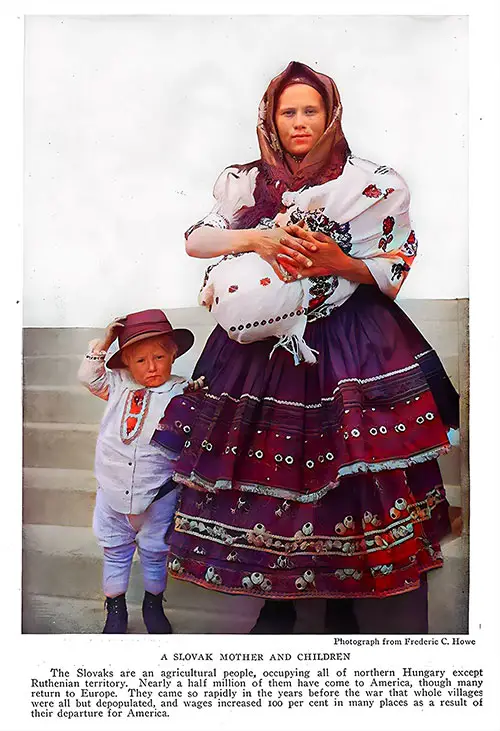
A Slovak Immigrant Mother and Her Children at Ellis Island. The Slovaks are an agricultural people, occupying all of northern Hungary except Ruthenian territory. Nearly a half-million of them have come to America, though many of them return to Europe. They came so rapidly in the years before the war that whole villages were all but depopulated, and wages increased 100 percent in many places as a result of their departure for America. Photograph from Frederic C. Howe. The National Geographic Magazine, February 1917. GGA Image ID # 14cea03690
Different communities took different views on education in those early times. In Connecticut, every town that did not keep school for at least three months in the year was fined.
Governor Berkeley thanked Cod in Virginia for not having free schools or printing presses. He hoped they would not arrive during his century since he believed that learning brought disobedience, heresy, and sects into the world, and printing developed them.
At one time, in Virginia, 40 percent of the 12,455 male adults who signed deeds and depositions made their marks.
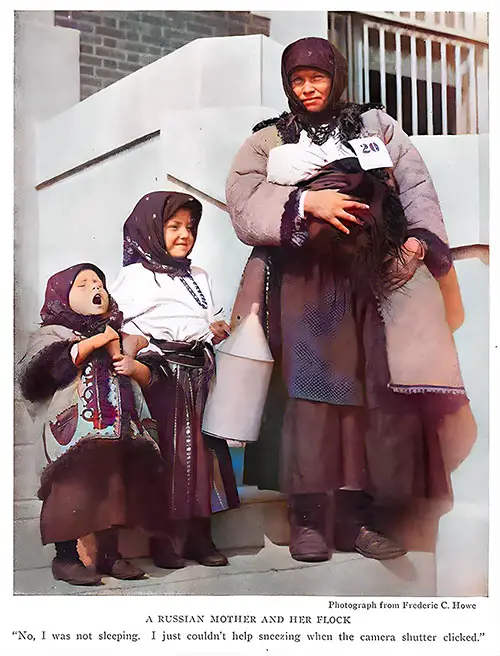
A Russian Immigrant Mother and Her Children at Ellis Island. "No, I was not sleeping. I just couldn't help sneezing when the camera shutter clicked." Photograph from Frederic C. Howe. The National Geographic Magazine, February 1917. GGA Image ID # 14cea1cd49
Immigration to the United States was not significant in the country's early history. Europe did not favor the young Republic, and the people of that continent did not regard America as an attraction for the ambitious home-seeker.
Between 1776 and 1820, a period of 44 years, less than 250,000 immigrants are believed to have arrived in the United States — an average of fewer than 6,000 a year.
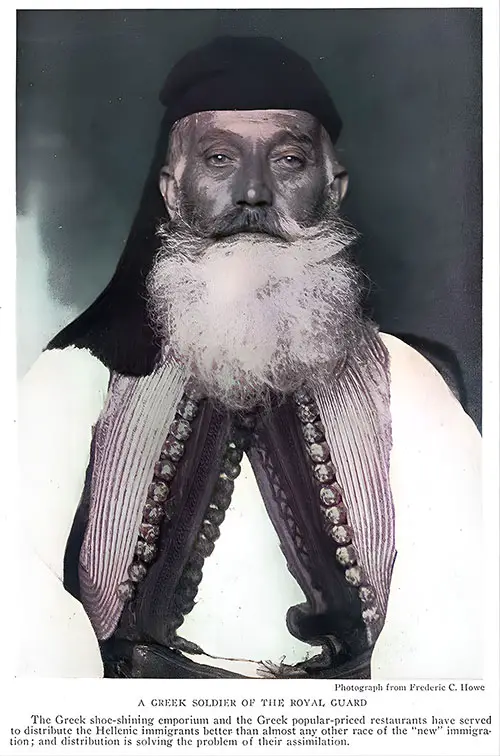
A Greek Soldier of the Royal Guard at Ellis Island. The Greek shoe-shining emporium and the Greek popular-priced restaurants have served to distribute the Hellenic immigrants better than almost any other race of the "new" immigration, and distribution is solving the problem of their assimilation. Photograph from Frederic C. Howe. The National Geographic Magazine, February 1917. GGA Image ID # 14ced521b1
The students of immigration differentiate between the immigrants from northwestern Europe and those from southern and eastern Europe by calling them "old" and "new," respectively.
The "old" immigrant arrived with his family and desired to make America their home. Only sixteen out of every hundred of the "old" immigrants returned to Europe, and more than two-fifths of those who came were females.
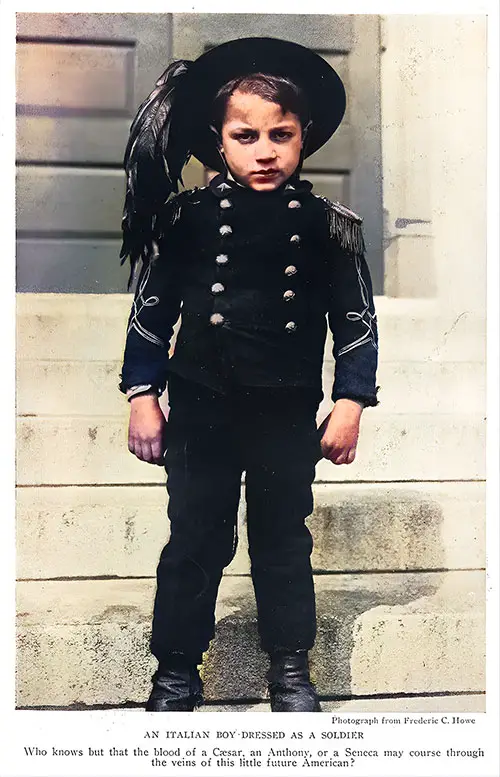
An Italian Immigrant Boy Dressed as a Soldier. Who knows but that the blood of a Caesar, an Anthony, or a Seneca may course through the veins of this little future American? Photograph from Frederic C. Howe. The National Geographic Magazine, February 1917. GGA Image ID # 14cee50245
On the other hand, thirty-eight out of every hundred "new" immigrants return to their native lands, while only one-fourth of those who come are females.
This shows that proportionately, more than twice as many of the "new" immigrants return to Europe as the "old." In contrast, the number of women among the "new" is vastly smaller.
Labor's Debt to Immigration
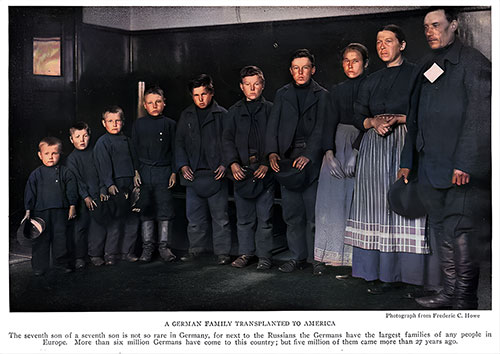
A Large German Immigrant Family Transplanted to America. The seventh son of a seventh son is not so rare in Germany, for next to the Russians, the Germans have the largest families of any people in Europe. More than six million Germans have come to this country, but live million of them came more than 27 years ago. Photograph from Frederic C. Howe. The National Geographic Magazine, February 1917. GGA Image ID # 14ceea9a65
Northwestern Europe has given us 17.000,000 immigrants, whereas southern and eastern Europe have sent us 15,000,000.
The labor supply that immigrants have brought to the nation constitutes an incalculable debt. Seven out of every ten workers in our iron and steel industries are drawn from this class; seven of our bituminous coal miners belong to it.
Three out of four of those who work in packing towns were born abroad or are children of those who were born overseas; four out of five of those who make our silk goods; seven out of eight of those employed in our woolen mills, nine out of ten of those who refine our petroleum, and nineteen out of twenty of those who manufacture our sugar are immigrants or children of immigrants.
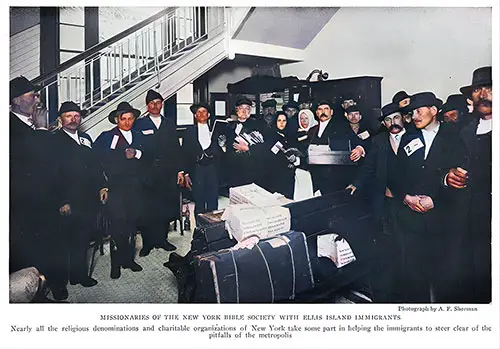
Missionaries of the New York Bible Society met with Ellis Island Immigrants. Nearly all the religious denominations and charitable organizations of New York take some part in helping the immigrants to steer clear of the pitfalls of the metropolis. Photograph by A. F. Sherman. The National Geographic Magazine, February 1917. GGA Image ID # 14cf1cf50a
The story of Calumet, in the northern part of Michigan, shows how much of a monopoly the immigrant has in the mining industry in America. It is a city of 45,000 people who live and work in the copper mines under Lake Superior. Twenty different races share its population, and not even Babel heard more tongues.
Sixteen nationalities are represented in its school-teaching force. In New York, the foreigners colonized, as on the Eastside. In Calumet, the native population was colonized, and the American colony was known as Houghton.
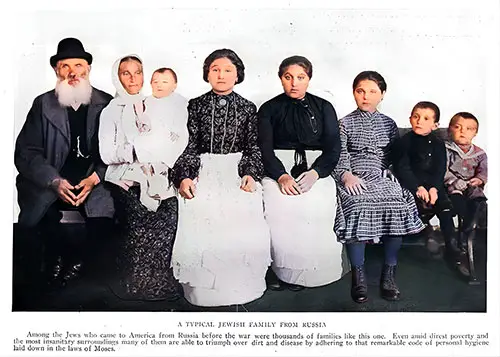
A Typical Russian Jewish Immigrant Family at Ellis Island. Among the Jews who came to America from Russia before the war were thousands of families like this one. Even amid direst poverty, the most unsanitary surroundings, many of them can triumph over dirt and disease by adhering to that remarkable code of personal hygiene laid down in the laws of Moses. National Geographic Magazine, February 1917. GGA Image ID # 14cf4a3188
Americans sometimes are inclined to complain about lowering wage standards through the advent of the "new" immigrant. Where once the native citizen and the homebuilder from northwestern Europe had to engage in ditch digging and dirty and dangerous occupations, the coming of the "new" stream of humanity has released them from such tasks and has permitted them to take higher positions in the industrial world.
The Irish, German, Welsh, and Scandinavian within our gates, along with the native American working man, are now able to devote almost wholly their time to skilled labor and overseeing the "new" immigrants in the industrial centers. The latter is the ladder on which his predecessor climbed.
Moving into Better Quarters
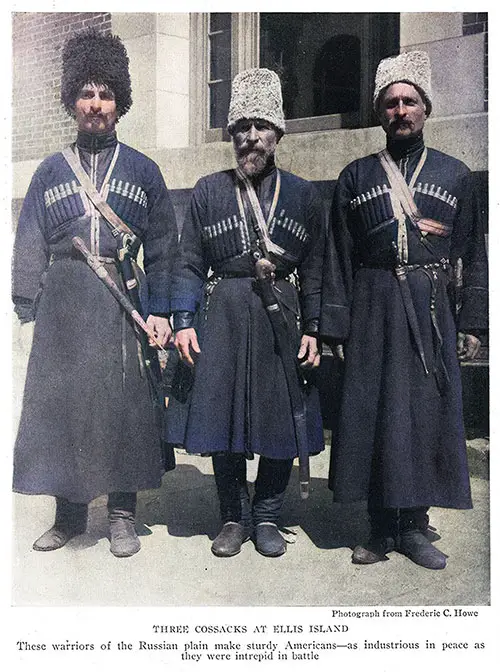
Three Russian Cossacks at Ellis Island. These warriors of the Russian plain make sturdy Americans — as industrious in peace as they were fearless in battle. Photograph from Frederic C. Howe. The National Geographic Magazine, February 1917. GGA Image ID # 14cf66d18e
Go to New York or any other principal city. You will find that the quarters that were once occupied by the Germans, the Irish, the English, and the Scandinavians are now occupied by the Italians, the Slavs, and the immigrant Jews.
Their coming has permitted the foreign-born who came in earlier decades to command better positions and live under better conditions than they otherwise could have.
From whatever country the immigrant comes from, he is, as a rule, above the average of the working classes in his community, for money is scarce in southern and eastern Europe. The peasant who can accumulate enough to bring him to the United States must have some purpose, a fair share of ambition, and little ability to practice self-denial. The vast majority of them come from small villages in rural districts.
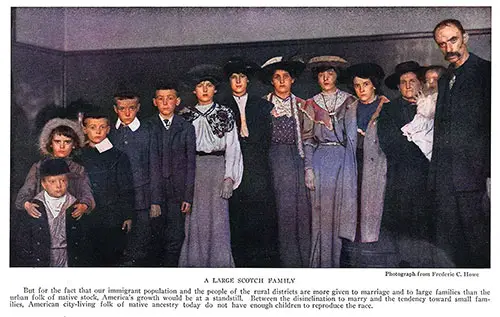
A Large Scottish Immigrant Family. But for the fact that our immigrant population and the people of the rural districts are more given to marriage and to large families than the urban folk of native stock, America's growth would be at a standstill. Between the disinclination to marry and the tendency toward small families, American city-living folk of native ancestry today do not have enough children to reproduce the race. Photograph from Frederic C. Howe. The National Geographic Magazine, February 1917. GGA Image ID # 14d0021a9b
That the alien's children are less illiterate than he is, that they commit less crime than he does, and have less tendency to insanity than he is shown by the statistics gathered by the United States Bureau of the Census and by the Immigration Commission of 1911.
Furthermore, these statistics prove that his grandchildren are about as free from illiteracy as the American child of native lineage and even less disposed to insanity than the child whose ancestry may be traced to colonial times.
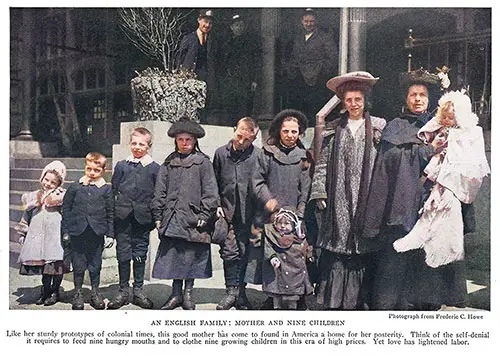
A Large English Immigrant Family – A Mother with Her Nine Children. Like her sturdy prototypes of colonial times, this good mother has come to find in America, a home for her posterity. Think of the self-denial it requires to feed nine hungry mouths and to clothe nine growing children in this era of high prices. Yet love has lightened labor. Photograph from Frederic C. Howe. National Geographic Magazine, February 1917. GGA Image ID # 14d00e2d0e
In everything that goes to show good citizenship, the grandchild of the immigrant stands the statistical test as well as the child of native parentage. No one can say how many immigrants we shall receive in the future.
But assuming that we have no immigration and that the United States will grow as fast during the three centuries ahead of us as Europe grew from 1812 to 1912, we will have a population of nearly 500.000,000 in 2217 or approximately 166 to the square mile.
Agricultural students have declared that the soil of the United States has a sustaining power of 500 to the square mile. Assuming that one-third of the country is occupied by wasteland, we have room on this basis for 900,000,000 people.
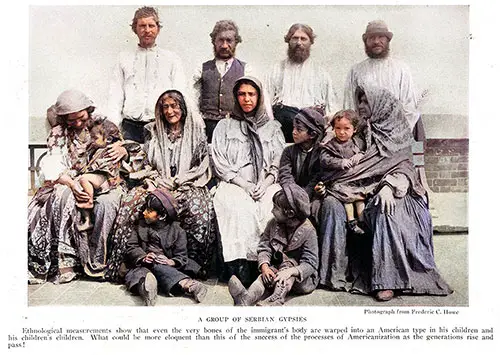
A Group of Serbian Gypsies at Ellis Island. Ethnological measurements show that even the very bones of the immigrant's body are warped into an American type in his children and his children s children. What could be more eloquent than this of the success of the processes of Americanization as the generations rise and pass! Photograph from Frederic C. Howe. The National Geographic Magazine, February 1917. GGA Image ID # 14d03f0d05
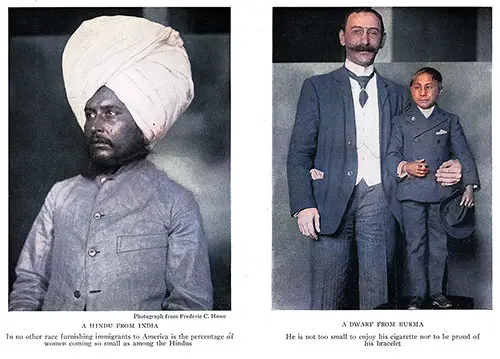
Immigrants Landing at Ellis Island. On the Right, a Hindu from India. In no other race, furnishing immigrants to America is the percentage of women coming so small as among the Hindus. On the Right, a Dwarf from Myanmar (Burma). He is not too short to enjoy his cigarette nor to be proud of his bracelet. Photographs from Frederic C. Howe. The National Geographic Magazine, February 1917. GGA Image ID # 14d0a9f3c4
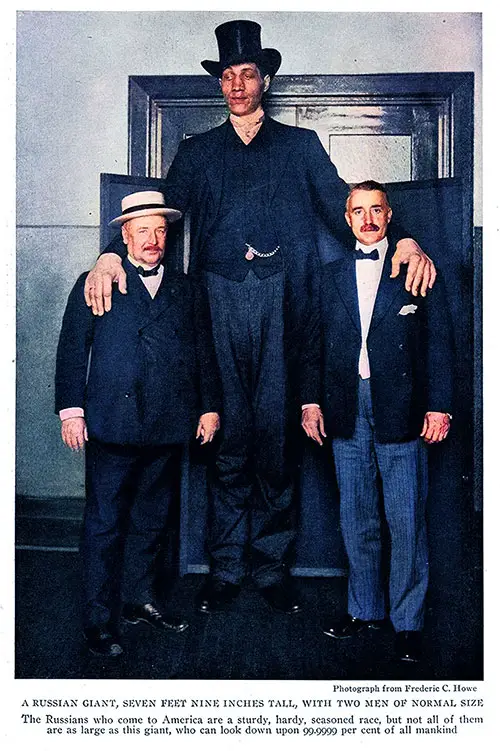
A Giant Russian Immigrant, Seven Feet, Nine Inches Tall, Shown Here with Two Men of Normal Size. The Russians who come to America are a sturdy, hardy, seasoned race, but not all of them are as large as this giant, who can look down upon 99.9999 percent of all mankind. Photograph from Frederic C. Howe. The National Geographic Magazine, February 1917. GGA Image ID # 14d0b1b265
"Our Foreign-Born Citizens," in The National Geographic Magazine, Washington DC: National Geographic Society, Vol. XXXI, No. 2, February 1917, pp. 95-130.
Key Highlights and Engaging Content
Historical Context of Immigration to the U.S.:
The article places immigration within the broader context of American history, explaining how immigration waves have contributed to the nation’s development. The section on foreign stock in the population provides fascinating insights into how, by 1917, a significant portion of the U.S. population was of immigrant descent.
The accompanying map showing foreign stock by state reveals how immigrants and their children outnumbered those of native stock in several states, painting a picture of America as a nation shaped by its immigrant communities.
The Literacy Test and Its Impact:
One of the most compelling sections is the discussion of the literacy test introduced to restrict certain immigrant groups. It highlights how, historically, policies such as the literacy test disproportionately impacted immigrants from Eastern and Southern Europe.
The statistics showing that a large percentage of immigrants from these regions were illiterate provides context to the tension between America’s traditional openness to immigration and the rising concerns over national security and assimilation during wartime.
Immigrant Contributions to American Society:
The article emphasizes the immigrants’ contributions to the country, from labor in industries such as coal mining and steel production to cultural influences that shaped American life.
The mention of how immigrants helped populate vast areas of the U.S. and the essential roles they played in the workforce paints a clear picture of their economic and social importance.
The article underscores that despite the challenges and prejudices faced by immigrants, they were integral to America's growth.
📸 Noteworthy Images:
📌 Map Showing the Foreign Stock in the Population: This image effectively illustrates the geographical spread of immigrant populations across the United States, highlighting areas with a high concentration of immigrant descendants.
📌 Scottish Immigrant Children at Ellis Island: This image captures the diversity of immigrants arriving at Ellis Island, with Scottish children symbolizing the deep-rooted history of immigration in the U.S. and their integral role in shaping American culture.
📌 Russian Hebrew Vegetarian Immigrant at Ellis Island: The portrait of this immigrant individual standing at Ellis Island adds a personal touch to the broader historical narrative, symbolizing the diversity of people arriving at America’s gateway and the cultural exchanges that defined the immigrant experience.
The Changing Immigration Landscape:
The article concludes with reflections on the future of immigration, particularly in light of the World War I and its impact on immigration patterns. With the war disrupting traditional migration patterns, the article raises questions about how future immigrants will impact American society, particularly in a post-war world.
Educational and Historical Insights
This article is rich in educational insights related to the study of U.S. immigration. It introduces essential concepts such as ethnic diversity, assimilation, immigration laws, and labor contributions, making it a valuable resource for understanding immigrant experiences in the U.S. during the early 20th century.
Additionally, it serves as an excellent case study in the evolving public attitudes towards immigration—shifting from openness and opportunity to a more restrictive and selective approach due to political and economic pressures.
The historical and sociopolitical context is particularly useful for genealogists tracing immigrant origins, as it offers a backdrop against which specific immigrant groups can be placed within larger historical trends. Additionally, it provides insight into policy changes that have shaped modern immigration laws.
Final Thoughts
The article is a rich, informative source that connects historical trends with contemporary concerns. For those interested in understanding the role of immigrants in American society, this article provides an important perspective on how immigration policies have evolved and their social impact. The use of personal photographs and detailed maps helps humanize the experience of immigrants, making it a compelling and accessible read for a wide audience.
🔎 Research & Essay Writing Using GG Archives
📢 This is NOT a blog! Instead, students and researchers are encouraged to use the GG Archives materials for academic and historical research.
🔎 Looking for primary sources on Titanic’s lifeboat disaster? GG Archives provides one of the most comprehensive visual collections available today.

